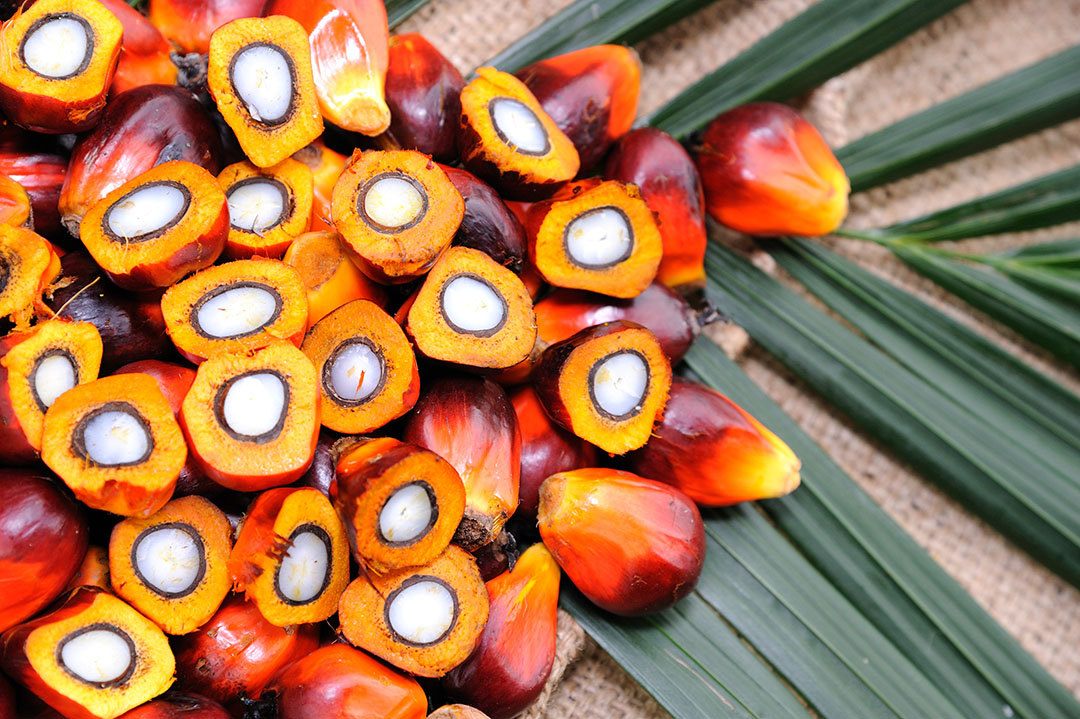MCFAs, the solution of the past

MCFA based products have been actively used in feed formulation for the past 15 years. Raw materials high in MCFA have a proven track record regarding positive effects on animal performance while exerting antibacterial activity. With the roaring 20’s at our doorstep, now is the time to move forward with MCFAs and MONOs in the mix.
Providing animals with medium chain fatty acids (MCFA) can be achieved through multiple strategies. The most well-known option would be to include additives based on MCFA in the diet formulations or supplement them through drinking water. However, these options have as a downside that it is costly to include functional dosages. Wouldn’t it be more preferable to use a product that already contains high amounts of MCFAs?
Physical refining of palm kernel oil for human consumption results in the by-product, palm kernel fatty acid distillates (PKFAD). On average, MCFA account for 60% of the fatty acid profile, from which 70% are present in free form and 30% mainly as triglycerides. Initially, PKFAD was used only as a good energy source in animal feed. The energy value and digestibility is comparable to that of soybean oil and in young animals, the digestibility of MCFAs is even higher than that of long chain unsaturated fatty acids. Nowadays, PKFAD has proven to be a functional ingredient for the reduction of pathogenic (gram positive) bacterial growth and helps to enhance gut health and absorption capacity of the gastrointestinal tract. A strong improvement in feed conversion and performance of the animal is often observed as result of feeding PKFAD. PKFAD is widely used by feed compounders in Europe and has become a standard ingredient in optimising antibiotic growth promoter (AGP) -free feed for pigs and poultry.
Balancing the functions
Practice has shown that the usage of MCFA, and especially of lauric acid, knows a maximum inclusion level. Fatty acids have the ability to regulate gastrointestinal function and even more important, suppress energy intake. Exceeding the maximum level thus has detrimental effects on feed intake and should be avoided. On the other hand, a certain load of MCFAs should be included to significantly lower the level of total bacteria and specifically the number of Lactobacillus in the ileum of broilers and to observe an effect on feed conversion.
Animal performance results obtained when using MCFA can show slight variations, depending for example on physiological status of the animal and buffering capacity of the feed. In order to overcome the volatility in results, improved molecules derived from fatty acids have been developed. These molecules are called α-monoglycerides and they are temperature and pH independent, which means that they won’t lose performance capacity in the feed or under different physiological circumstances. Research has shown that monoglycerides have a stronger antibacterial or antiviral effect compared to their corresponding organic acids. Depending on the chain length of the fatty acid, the monoglycerides will be more active against gram-negative or gram-positive bacteria or even against fat enveloped viruses. This effect can be measured using a MIC (minimum inhibitory concentration) test. The results from this test show the lowest concentration of a substance that prevents visible growth of a bacterium. MIC values of several fatty acids, their corresponding monoglycerides and combinations are shown in Figure 1. This clearly shows the increase in antibacterial effect against multiple bacteria from monoglycerides versus their corresponding free fatty acids. On top of that, synergistic relationships are observed between monolaurin and lauric acid when their 2 component mixtures are examined. The MIC value of the mixture is lower than that of the 2 single components (15 vs 31 and 125 µg/ml) and can be achieved using different ratios of monoglycerides and free fatty acids.
Figure 1 – Minimum inhibitory concentration value of fatty acids and monoglycerides against multiple bacteria.

Efficacy in practice
This synergistic relationship formed the starting point for the development of the product Phytolipogenics (PLG) Plus. This is a carefully formulated blend consisting of a wide range of monoglycerides in combination with PKFAD which results in a cost effective, antibacterial fat. Marvesa carried out an experiment where PLG Plus was tested in broiler diets from day 0 to 35. 198 day-old Ross 308 broilers were randomly distributed over 33 cages.
There were 3, practically isocaloric, experimental treatment groups with 11 replicates each.
- The control treatment consisted of a basal corn and wheat based starter, grower and finisher diet with soy- and palm oil as fat sources. No additives were used in the formulation.
- Treatment group 1 ‘PLG Plus High’ received the control diet with 2%, 1.5% and 1% of soy oil replaced by PLG Plus.
- Treatment group 2 ‘PLG Plus Low’ received the control diet with 1.4%, 1.05% and 0.7% of soy oil replaced by PLG Plus, see Table 1.
The PLG Plus High group outperformed the control diet on all parameters from day 0-35, especially in the grower phase from day 10-25. Both the high and low groups had significantly improved feed conversion from day 0-35. Next to better performance, at day 21 litter is scored better for both treatment groups. This might be an indication for improved gut health caused by the reduction of pathogenic bacteria and higher fat-digestibility. The significant improvement in feed conversion rate and the slight increase in body weight gain yielded an economical advantage of almost € 20/1000 broilers from the ‘high’ supplemented group. The increased revenue fully compensates for higher feeding costs, resulting in a more cost effective, strongly antibacterial product active against gram-negative bacteria, gram-positive bacteria and fat coated viruses compared with soybean oil.
The use of fatty acids from different chain lengths and in different forms will inhibit the growth of a wide range of bacteria. A combination of free fatty acids, monoglycerides and triglycerides of SCFA and MCFA will result in a release of these components throughout the whole digestive tract, ensuring improvement of animal health and production performance. This natural protection helps the transition to an AGP-free industry.
Author: Rian Kloetstra, Nutritional department, Marvesa







